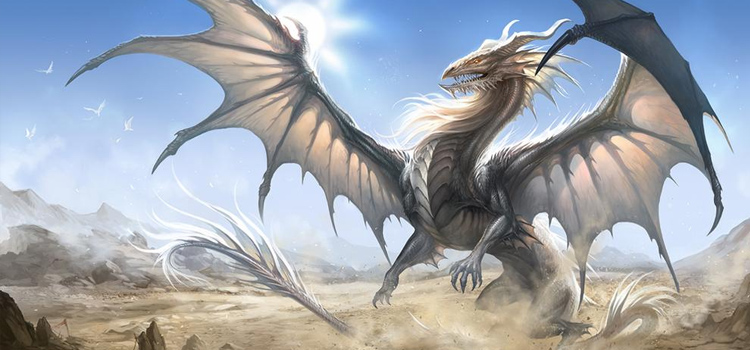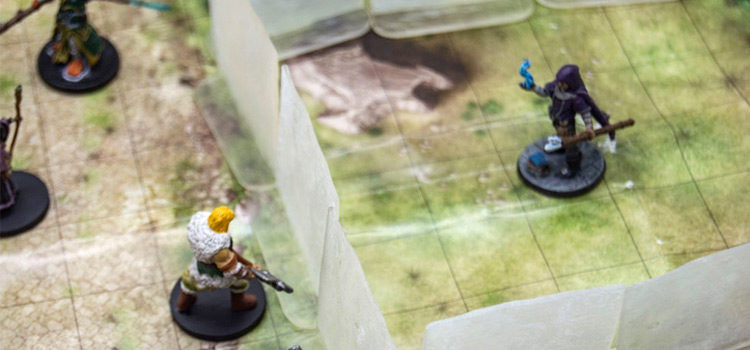Dragon’s Breath: D&D 5e Spell Guide
This post may contain affiliate links. If you buy something we may get a small commission at no extra cost to you. (Learn more).
Wield the awesome power of ancient dragons by magically imbuing your breath to exhale elemental damage.
This thematic (and fun) spell can be a tricky one to use correctly, but is well worth the spell choice for some adventurers.
Dragon’s Breath Spell Details
Available To: Sorcerer/Wizard
School of Magic: Transmutation
Level of Spell: 2nd Level
Casting Time: 1 bonus action
Range: Touch
Duration: 1 minute (concentration)
Components: verbal, somatic, material (a hot pepper)
Source: Xanathar’s Guide to Everything page 154
You can select one willing creature to emit a 15-foot cone of elemental damage from its mouth.
Upon touching the creature you may choose acid, cold, fire, lightning or poison as the damage type for the breath effect.
Creatures in the spell effect area make a Dexterity saving throw, taking 3d6 damage with a failure, then half as much damage on a success.
What Does This Mean?
Dragon’s Breath is a small area of effect spell that deals decent damage for the level it is.
And as part of being a concentration spell, the destructive exhalation can be repeated for potentially every round of the combat (up to 10 rounds).
It covers a 15-foot cone, which would equate to a maximum of 3 medium sized targets if they were close together. A key point of this spell is that it can be cast on any willing creature that has a mouth – a point that’s vital to making this a valuable spell.
Who Gets It?
This spell is on the wizard and sorcerer spell list, which means it can also be picked up by Arcane Trickster Rogues and Eldritch Knight Fighters as their non-specific school spell at level 8.
Which would be an excellent choice, as will be explained below.
Dragon’s Breath: Pros
Firstly, being able to choose the damage type is a massive perk for being able to get around damage resistances or immunities that an opponent might have.
For example, if you come up against a group of Yuan-Ti just determined to sacrifice your NPC pal, you would know not to drop the poison breath on them since it would have no effect.
So you reduce them to ash with a classic fire breath.
Another bonus to the spell is that it only takes a bonus action to cast.
This leaves your action to exhale the spell effect, or to cast a cantrip or make a weapon attack if you cast the spell on another creature.
Dragon’s Breath: Cons & Downsides
The main issue with this spell is that it’s a concentration spell, which puts it up against a host of very powerful spells. Particularly as you gain higher level spell slots.
Even as a second level spell, the fact that it requires concentration will force a player to choose between controlling the battlefield with a spell like web, or to target damage on an individual like Maximillian’s earthen grasp.
Even as an area of effect spell, shatter has the potential to inflict more damage on a greater number of creatures in one go.
Additionally, although casting the spell is a bonus action, to actually exhale the damaging effect requires an action on each turn.
At low levels, the damage output from this is respectable, and therefore worth the action economy cost. But beyond level 5 there are better options for most spellcasters and martial characters.
For a sorcerer, the spell is not well suited to many metamagic effects. It’s cast on a creature who then uses their action to exhale energy, so the actual spell effect is not at the same point as the casting.
It’s even unable to be twinned, as the lead rules designer of WoTC has clarified.
Roleplay Ideas
One of my favorite things about this spell is that the material component needed is a hot pepper.
The visual of biting down on a chili and then breathing fire is a wonderful image… or even handing out jalapenos when you cast the spell on others.
The draconic nature of the spell also makes it a great one for any character wanting to play a connection to some of the most powerful creatures in the worlds of D&D (looking at you Draconic sorcerers).
Dragon’s Breath Uses
At low levels, this a great option to cast on a martial character that doesn’t have access to magical damage yet.
Especially if you’re facing a foe with resistances or immunities to the usual slashing, piercing, or bludgeoning damage (such as lycanthropes).
What’s even better is if an ally can cast invisibility on the same character, the special features of dragon’s breath means they’ll be able to stay invisible while exhaling the damage (although the flaming breath might give away their position).
The Dragon Death Drone
The ultimate way to use dragon’s breath is to cast it on a familiar (best gained through the ritual caster or magic initiate feat, or multiclassing a level into wizard or three into warlock for pact of the chain).
The beauty of this method is that a familiar meets the requirements of the spell: it’s willing, has a mouth, and most importantly, because exhaling the energy is neither an attack nor casting a spell, a familiar can do it.
This has even been confirmed by the WoTC lead rules designer.
Be warned that this tactic puts a big target on your familiar.
Any DM playing their monsters with a bit of smarts will kill your 1hp companion pretty quickly, unless you can keep them out of harm’s way.
Because of this, the owl is a great choice for your familiar’s form as its flyby feature lets it stay out of other creature’s reach without provoking attacks of opportunity.
A warlock multi-class could also have an imp, quasit, or sprite familiar that could be invisible while using dragon’s breath, making then harder to find and hit.
Dragon’s Breath Builds
This spell is a perfect choice for an Eldritch knight. And to a lesser extent an arcane trickster character.
At third level, when a fighter or rogue takes one of these subclasses, the find familiar spell is a must have. So why not use your limited and low level spell slot choices on an option making the most of that excellent familiar?
It’s also important to consider having a good constitution ability score, or the war caster feat. Just to make sure you can maintain concentration on the spell each time you take damage.
Final Insights
Dragon’s Breath is an awesome and thematic spell for spell casters with lower level spell slots available, that can cause tactical area of effect damage aggressively.
But it can soon be outpaced by more powerful higher-level spells that use your concentration. A solid part to your strategy, but probably not a full strategy by itself.






